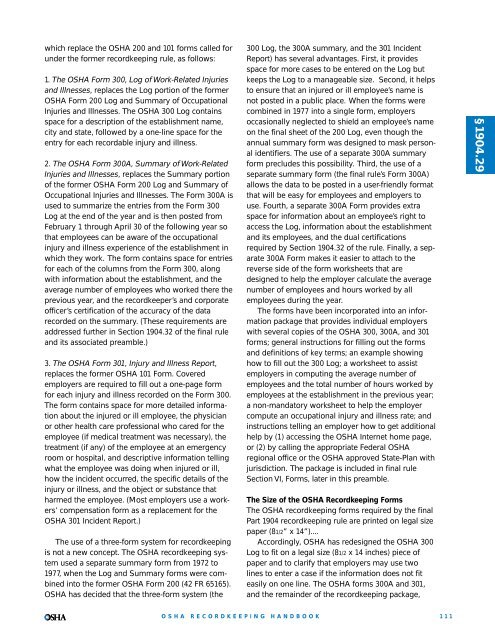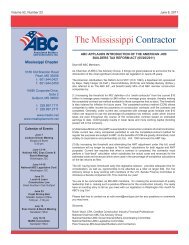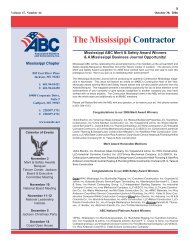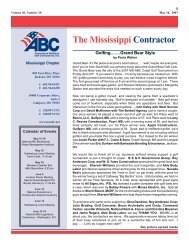§1904.29cern cases, and the list must include the employee’sname and the case number from the <strong>OSHA</strong> 300 Log.This separate listing is needed to allow a governmentrepresentative to obtain the employee’s name duringa workplace inspection in case further investigation iswarranted and to assist employers to keep track ofsuch cases in the event that future revisions to theentry become necessary.Paragraph 1904.29(b)(7) defines “privacy concerncases” as those involving: (i) An injury or illness to anintimate body part or the reproductive system; (ii) aninjury or illness resulting from a sexual assault; (iii) amental illness; (iv) a work-related HIV infection, hepatitiscase, or tuberculosis case; (v) needlestickinjuries and cuts from sharp objects that are contaminatedwith another person’s blood or other potentiallyinfectious material, or (vi) any other illness, if theemployee independently and voluntarily requeststhat his or her name not be entered on the log.Paragraph 1904.29(b)(8) establishes that these are theonly types of occupational injuries and illnesses thatthe employer may consider privacy concern cases forrecordkeeping purposes.Paragraph 1904.29(b)(9) permits employers discretionin recording case information if the employerbelieves that doing so could compromise the privacyof the employee’s identity, even though the employee’sname has not been entered. This clause hasbeen added because <strong>OSHA</strong> recognizes that, for specificsituations, coworkers who are allowed to accessthe log may be able to deduce the identity of theinjured or ill worker and obtain inappropriate knowledgeof a privacy-sensitive injury or illness. <strong>OSHA</strong>believes that these situations are relatively infrequent,but still exist. For example, if knowing thedepartment in which the employee works wouldinadvertently divulge the person’s identity, or recordingthe gender of the injured employee would identifyingthat person because, for example, only onewoman works at the plant, the employer has discretionto mask or withhold this information both on theLog and Incident Report.The rule requires the employer to enter enoughinformation to identify the cause of the incident andthe general severity of the injury or illness, but allowsthe employer to exclude details of an intimate or privatenature. The rule includes two examples; a sexualassault case could be described simply as “injuryfrom assault,” or an injury to a reproductive organcould be described as “lower abdominal injury.”Likewise, a work-related diagnosis of post traumaticstress disorder could be described as “emotional difficulty.”Reproductive disorders, certain cancers, contagiousdiseases and other disorders that are intimateand private in nature may also be described ina general way to avoid privacy concerns. This allowsthe employer to avoid overly graphic descriptionsthat may be offensive, without sacrificing the descriptivevalue of the recorded information.Paragraph 1904.29(b)(10) protects employee privacyif the employer decides voluntarily to disclose the<strong>OSHA</strong> 300 and 301 forms to persons other than thosewho have a mandatory right of access under the finalrule. The paragraph requires the employer to removeor hide employees’ names or other personally identifyinginformation before disclosing the forms topersons other than government representatives,employees, former employees or authorized representatives,as required by paragraphs 1904.40 and1904.35, except in three cases. The employer maydisclose the forms, complete with personally identifyinginformation, [ ] only: (i) to an auditor or consultanthired by the employer to evaluate the safety andhealth program; (ii) to the extent necessary for processinga claim for workers’ compensation or otherinsurance benefits; or (iii) to a public health authorityor law enforcement agency for uses and disclosuresfor which consent, an authorization, or opportunity toagree or object is not required under section 164.512of the final rule on Standards for Privacy of IndividuallyIdentifiable Health Information, 45 CFR 164.512.These requirements have been included inSection 1904.29 rather than in Section 1904.35, whichestablishes requirements for records access, becausewaiting until access is requested to remove identifyinginformation from the <strong>OSHA</strong> 300 Log could unwittinglycompromise the injured or ill worker’s privacyand result in unnecessary delays. The final rule’soverall approach to handling privacy issues is discussedmore fully in the preamble discussion of theemployee access provisions in Section 1904.35.The Treatment of Occupational Illness and Injury Dataon the FormsThe treatment of occupational injury and illness dataon the <strong>OSHA</strong> forms is a key issue in this rulemaking.Although the forms themselves are not printed in theCode of Federal Regulations (CFR), they are themethod <strong>OSHA</strong>’s recordkeeping regulation uses tomeet the Agency’s goal of tracking and reportingoccupational injury and illness data. As such, theforms are a central component of the recordkeepingsystem and mirror the requirements of the Part 1904regulation. The final Part 1904 rule requires employersto use three forms to track occupational injuriesand illnesses: the <strong>OSHA</strong> 300, 300A, and 301 forms,110<strong>OSHA</strong> RECORDKEEPINGHANDBOOK
which replace the <strong>OSHA</strong> 200 and 101 forms called forunder the former recordkeeping rule, as follows:1. The <strong>OSHA</strong> Form 300, Log of Work-Related Injuriesand Illnesses, replaces the Log portion of the former<strong>OSHA</strong> Form 200 Log and Summary of OccupationalInjuries and Illnesses. The <strong>OSHA</strong> 300 Log containsspace for a description of the establishment name,city and state, followed by a one-line space for theentry for each recordable injury and illness.2. The <strong>OSHA</strong> Form 300A, Summary of Work-RelatedInjuries and Illnesses, replaces the Summary portionof the former <strong>OSHA</strong> Form 200 Log and Summary ofOccupational Injuries and Illnesses. The Form 300A isused to summarize the entries from the Form 300Log at the end of the year and is then posted fromFebruary 1 through April 30 of the following year sothat employees can be aware of the occupationalinjury and illness experience of the establishment inwhich they work. The form contains space for entriesfor each of the columns from the Form 300, alongwith information about the establishment, and theaverage number of employees who worked there theprevious year, and the recordkeeper’s and corporateofficer’s certification of the accuracy of the datarecorded on the summary. (These requirements areaddressed further in Section 1904.32 of the final ruleand its associated preamble.)3. The <strong>OSHA</strong> Form 301, Injury and Illness Report,replaces the former <strong>OSHA</strong> 101 Form. Coveredemployers are required to fill out a one-page formfor each injury and illness recorded on the Form 300.The form contains space for more detailed informationabout the injured or ill employee, the physicianor other health care professional who cared for theemployee (if medical treatment was necessary), thetreatment (if any) of the employee at an emergencyroom or hospital, and descriptive information tellingwhat the employee was doing when injured or ill,how the incident occurred, the specific details of theinjury or illness, and the object or substance thatharmed the employee. (Most employers use a workers’compensation form as a replacement for the<strong>OSHA</strong> 301 Incident Report.)The use of a three-form system for recordkeepingis not a new concept. The <strong>OSHA</strong> recordkeeping systemused a separate summary form from 1972 to1977, when the Log and Summary forms were combinedinto the former <strong>OSHA</strong> Form 200 (42 FR 65165).<strong>OSHA</strong> has decided that the three-form system (the300 Log, the 300A summary, and the 301 IncidentReport) has several advantages. First, it providesspace for more cases to be entered on the Log butkeeps the Log to a manageable size. Second, it helpsto ensure that an injured or ill employee’s name isnot posted in a public place. When the forms werecombined in 1977 into a single form, employersoccasionally neglected to shield an employee’s nameon the final sheet of the 200 Log, even though theannual summary form was designed to mask personalidentifiers. The use of a separate 300A summaryform precludes this possibility. Third, the use of aseparate summary form (the final rule’s Form 300A)allows the data to be posted in a user-friendly formatthat will be easy for employees and employers touse. Fourth, a separate 300A Form provides extraspace for information about an employee’s right toaccess the Log, information about the establishmentand its employees, and the dual certificationsrequired by Section 1904.32 of the rule. Finally, a separate300A Form makes it easier to attach to thereverse side of the form worksheets that aredesigned to help the employer calculate the averagenumber of employees and hours worked by allemployees during the year.The forms have been incorporated into an informationpackage that provides individual employerswith several copies of the <strong>OSHA</strong> 300, 300A, and 301forms; general instructions for filling out the formsand definitions of key terms; an example showinghow to fill out the 300 Log; a worksheet to assistemployers in computing the average number ofemployees and the total number of hours worked byemployees at the establishment in the previous year;a non-mandatory worksheet to help the employercompute an occupational injury and illness rate; andinstructions telling an employer how to get additionalhelp by (1) accessing the <strong>OSHA</strong> Inter<strong>net</strong> home page,or (2) by calling the appropriate Federal <strong>OSHA</strong>regional office or the <strong>OSHA</strong> approved State-Plan withjurisdiction. The package is included in final ruleSection VI, Forms, later in this preamble.The Size of the <strong>OSHA</strong> <strong>Recordkeeping</strong> FormsThe <strong>OSHA</strong> recordkeeping forms required by the finalPart 1904 recordkeeping rule are printed on legal sizepaper (81/2” x 14”)....Accordingly, <strong>OSHA</strong> has redesigned the <strong>OSHA</strong> 300Log to fit on a legal size (81/2 x 14 inches) piece ofpaper and to clarify that employers may use twolines to enter a case if the information does not fiteasily on one line. The <strong>OSHA</strong> forms 300A and 301,and the remainder of the recordkeeping package,§1904.29<strong>OSHA</strong> RECORDKEEPINGHANDBOOK111
- Page 1 and 2:
www.osha.govOSHARecordkeepingHandbo
- Page 3 and 4:
OSHARecordkeeping HandbookThe Regul
- Page 5 and 6:
ContentsRecordkeeping HandbookRoadm
- Page 7 and 8:
Section 1904.40Providing records to
- Page 9 and 10:
Section 1904.0Purpose(66 FR 6122, J
- Page 11 and 12:
Section 1904.1Partial exemption for
- Page 13 and 14:
Section 1904.2Partial exemption for
- Page 15 and 16:
employees, to OSHA within 8 hours (
- Page 17 and 18:
Partial Exemptions for Employers Un
- Page 19 and 20:
Section 1904.4Recording criteria(66
- Page 21 and 22:
Section 1904.5Determination of work
- Page 23 and 24:
(b)(7) How do I decide if a case is
- Page 25 and 26:
well, including providing informati
- Page 27 and 28:
This exception, which responds to i
- Page 29 and 30:
or she is in the work environment a
- Page 31 and 32:
have occurred but for the occupatio
- Page 33 and 34:
considered work-related. If an empl
- Page 35 and 36:
Question 5-12. Is work-related stre
- Page 37 and 38:
• The doctor described the illnes
- Page 39 and 40:
Scenario 7:• A site hired numerou
- Page 41 and 42:
Letter of interpretation related to
- Page 43 and 44:
These principles should be applied
- Page 45 and 46:
The problem with the response is tw
- Page 47 and 48:
Section 1904.6Determination of new
- Page 49 and 50:
the Guidelines stated that “the a
- Page 51 and 52:
estricted work. If the case is a pr
- Page 53 and 54:
• The doctor also prescribed the
- Page 55 and 56:
• The employees were under the di
- Page 57 and 58:
Section 1904.7General recording cri
- Page 59 and 60:
(iii) Do I have to record restricte
- Page 61 and 62:
of the length of time the employee
- Page 63 and 64:
then result in days away from work
- Page 65 and 66:
A partial day of work is recorded a
- Page 67 and 68: In all other respects, the final ru
- Page 69 and 70: ments. The Agency believes that the
- Page 71 and 72: e recorded because it will require
- Page 73 and 74: However, episodes of fainting from
- Page 75 and 76: care professional, he or she may al
- Page 77 and 78: “Other simple means” of removin
- Page 79 and 80: For purposes of OSHA recordkeeping
- Page 81 and 82: • When answering the doctor’s q
- Page 83 and 84: Response: In the recordkeeping regu
- Page 85 and 86: Letter of interpretation related to
- Page 87 and 88: Section 1904.8Recording criteria fo
- Page 89 and 90: caused by contaminated needles and
- Page 91 and 92: Section 1904.9Recording criteria fo
- Page 93 and 94: Section 1904.10Recording criteria f
- Page 95 and 96: hearing loss case that is not relat
- Page 97 and 98: average of 10 decibels or more at 2
- Page 99 and 100: argued that because the function of
- Page 101 and 102: occurs, and where hearing loss can
- Page 103 and 104: cases in their workplace via analys
- Page 105 and 106: March 4, 2004Mr. Carl O. Sall, CIHD
- Page 107 and 108: When the professional evaluating th
- Page 109 and 110: (2) May I line-out or erase a recor
- Page 111 and 112: Section 1904.12Recording criteria f
- Page 113 and 114: These new statistics would add only
- Page 115 and 116: Sections 1904.13 - 1904.28 Reserved
- Page 117: two lines of the OSHA 300 Log to de
- Page 121 and 122: different types of occupational ill
- Page 123 and 124: OSHA 301 form. These data are usefu
- Page 125 and 126: LETTERS OF INTERPRETATION: Section
- Page 127 and 128: Question 2: Under 29 CFR Section 19
- Page 129 and 130: and has adopted language in the fin
- Page 131 and 132: Section 1904.31Covered employees(66
- Page 133 and 134: label assigned to a worker is immat
- Page 135 and 136: These workers should be evaluated j
- Page 137 and 138: Response: A case is work-related if
- Page 139 and 140: Response: Section 1904.31 states th
- Page 141 and 142: Thank you for your interest in occu
- Page 143 and 144: year covered by the summary. The su
- Page 145 and 146: 2. Number of employees and hours wo
- Page 147 and 148: LETTERS OF INTERPRETATION: Section
- Page 149 and 150: Section 1904.33Retention and updati
- Page 151 and 152: June 23, 2003Mr. Edwin G. Foulke, J
- Page 153 and 154: Section 1904.34Change in business o
- Page 155 and 156: PREAMBLE DISCUSSION: Section 1904.3
- Page 157 and 158: Incident Report (Forms 300 and 301,
- Page 159 and 160: workers’ compensation claim. See
- Page 161 and 162: LETTERS OF INTERPRETATION: Section
- Page 163 and 164: Letter of interpretation related to
- Page 165 and 166: Question 3: Using the facts in Ques
- Page 167 and 168: Section 1904.37State recordkeeping
- Page 169 and 170:
tion, require employers to report f
- Page 171 and 172:
(5) If I receive a variance, may th
- Page 173 and 174:
Section 1904.39Reporting fatalities
- Page 175 and 176:
gation. Therefore, the final rule d
- Page 177 and 178:
Section 1904.40Providing records to
- Page 179 and 180:
ness. The government inspector may
- Page 181 and 182:
Response: The controlling employer
- Page 183 and 184:
FREQUENTLY ASKED QUESTIONS: Section
- Page 185 and 186:
OSHA and the BLS have worked togeth
- Page 187 and 188:
provide copies of the retained reco
- Page 189 and 190:
FREQUENTLY ASKED QUESTIONS: Section
- Page 191 and 192:
Section 1904.46Definitions(66 FR 61
- Page 193 and 194:
of business information. For exampl
- Page 195 and 196:
inconvenience associated with keepi
- Page 197 and 198:
skin disease, respiratory disorder,
- Page 199 and 200:
Question 2: Under 29 CFR Section 19
- Page 201:
www.osha.gov







